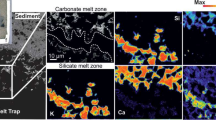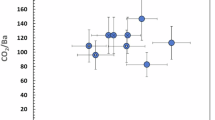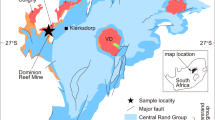Abstract
IN a recent letter Hamilton and Deans1 presented their results on the isotopic composition of strontium in carbonate rocks and strontium minerals, confirming the earlier discovery of Powell et al.2 that the isotopic composition of strontium in accepted carbonatites, which have so far been analysed, falls within a restricted range. The results have led both groups of workers to conclude that the source of these carbonatites is below the sial, a conclusion which would certainly meet with the approval of many geologists who have examined such rocks: postulation of this source, however, provokes the question of how the carbonatite rises through tens of kilometres of sialic crust without contamination. Probably the most widely accepted answer would be that most carbonatites are emplaced through a conduit already lined with co-magmatic or co-eval metasomatic products, and hence are protected from sialic contamination. If this were a valid explanation then it would be expected that some carbonatite intrusions, not so protected, might incorporate sialic material in their uprise and, because of the volatile-rich nature of the system, the strontium from the two sources would be rapidly equilibrated. Such a possibility is envisaged by Hamilton and Deans1 when they say that the atypical isotopic composition of the Keshya intrusive limestone might have resulted from “carbonatite assimilating granitic or sedimentary rocks”. Unlike the other carbonatites analysed the Keshya intrusion3 is indeed full of granitic xenolith material, and it is difficult, therefore, to see the basis for the subsequent statement of Hamilton and Deans1 that “Carbonatites show little evidence of assimilation on this scale … ”.
This is a preview of subscription content, access via your institution
Access options
Subscribe to this journal
Receive 51 print issues and online access
$199.00 per year
only $3.90 per issue
Buy this article
- Purchase on SpringerLink
- Instant access to full article PDF
Prices may be subject to local taxes which are calculated during checkout
Similar content being viewed by others
References
Hamilton, E. I., and Deans, T., Nature, 198, 776 (1963).
Powell, J. L., Hurley, P. M., and Fairbairn, H. W., Nature, 196, 1085 (1962).
Bailey, D. K., Quart. J. Geol. Soc. Lond., 117, 423, Plates XVI and XVIII (1961).
Author information
Authors and Affiliations
Rights and permissions
About this article
Cite this article
BAILEY, D. Isotopic Composition of Strontium in Carbonatites. Nature 201, 599 (1964). https://doi.org/10.1038/201599a0
Issue date:
DOI: https://doi.org/10.1038/201599a0
This article is cited by
-
Rifts, evaporites and the origin of certain alkaline rocks
Geologische Rundschau (1974)
-
Isotopic Composition of Strontium in Carbonate Rocks from Keshya and Mkwisi, Zambia
Nature (1965)



